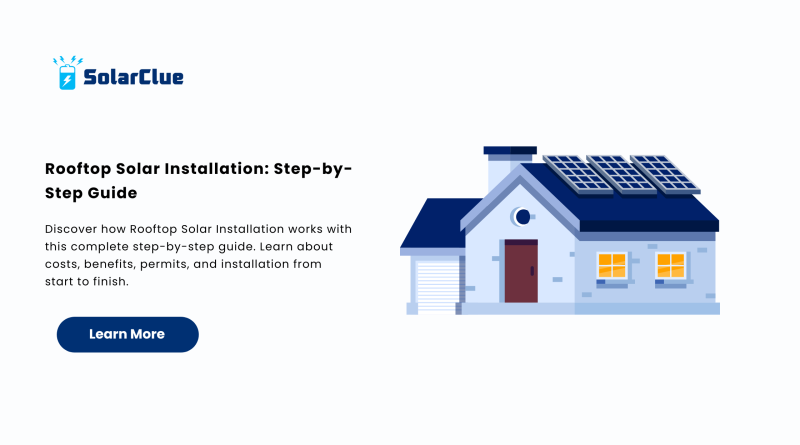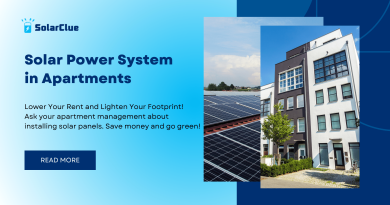Rooftop Solar Installation: Step-by-Step Guide
As the demand for clean and renewable energy grows, Rooftop Solar Installation has become a popular choice for homeowners and businesses. Whether you’re looking to cut electricity bills, reduce your carbon footprint, or become energy independent, a solar power system on your rooftop can help you achieve those goals. This guide walks you through the complete solar installation process, answering all your key questions along the way.
Table of Contents
- 1 What is a Rooftop Solar System?
- 1.1 Step 1: Site Assessment
- 1.2 Step 2: Energy Consumption Analysis
- 1.3 Step 3: Selecting Solar Components
- 1.4 Step 4: System Design and Proposal
- 1.5 Step 5: Permits and Documentation
- 1.6 Step 6: Installation Process
- 1.7 Step 7: Grid Connection and Net Metering
- 1.8 Step 8: Testing and Commissioning
- 1.9 Step 9: Maintenance and Support
- 2 Benefits of Rooftop Solar Installation
- 3 Common Myths About Solar
- 4 Environmental Impact of Solar
- 5 How to Choose a Solar Installation Company
- 6 Final Thoughts
- 7 FAQs
What is a Rooftop Solar System?
A rooftop solar system consists of solar photovoltaic (PV) panels mounted on the roof of a building. These panels absorb sunlight and convert it into electricity, reducing or even eliminating your dependence on traditional power sources. By installing a solar power system, you tap into a sustainable energy source that’s good for your wallet and the planet.
Step 1: Site Assessment
The first step in the solar installation process is a site assessment. A solar expert will inspect your roof to evaluate its condition, direction, tilt, shading, and overall suitability for Rooftop Solar Installation. This ensures your roof can support the panels and generate optimal solar energy. Moreover, this evaluation helps avoid performance issues later on.
Step 2: Energy Consumption Analysis
Next, Your current electricity usage is reviewed to determine the ideal size of your solar power system. Factors like daily usage patterns, peak load requirements, and potential future energy needs are taken into account to design the most efficient setup. As a result, the system will be tailored
Step 3: Selecting Solar Components
Choosing the right equipment is crucial for a reliable and efficient solar installation. You’ll need to select high-quality solar panels, inverters, mounting systems, and wiring. Most systems use either monocrystalline or polycrystalline solar panels depending on budget and efficiency goals. Furthermore, working with a trusted provider ensures durability and performance.
Step 4: System Design and Proposal
Based on the site assessment and energy analysis, a custom design is prepared. This includes panel layout, orientation, and tilt angles. You’ll receive a detailed proposal outlining system size, expected energy output, installation cost, savings forecast, and return on investment (ROI). Consequently, you can make an informed decision
Step 5: Permits and Documentation
Before installation begins, the necessary permits and approvals from your local utility and government authorities must be secured. Professional solar companies typically handle this paperwork on your behalf, ensuring smooth processing and compliance with local regulations. Therefore, you can avoid bureaucratic delays.
Step 6: Installation Process
Once permits are in place, the actual Rooftop Solar Installation begins. Mounting structures are fixed to the roof, solar panels are installed, and all components are connected. Wiring is done carefully, ensuring safety and reliability, and then the system is connected to your home’s electrical panel.
Step 7: Grid Connection and Net Metering
After installation, your system is connected to the power grid (if it’s a grid-tied system). Net metering allows you to send excess energy back to the grid and receive credits, further reducing your energy bills. This is one of the biggest advantages of a solar power system.
Step 8: Testing and Commissioning
The installed system is thoroughly tested to ensure everything works perfectly. Monitoring systems are set up so you can track your energy production in real-time and ensure optimal performance of your solar setup.
Step 9: Maintenance and Support
One of the best things about a Rooftop Solar Installation is that it requires minimal maintenance. Occasional cleaning and routine checks are enough to keep it running efficiently for 25+ years. Many providers also offer extended warranties and support services.
Benefits of Rooftop Solar Installation

-
Lower electricity bills: Generate your own electricity and rely less on the grid.
-
Low maintenance: Most systems are nearly maintenance-free.
-
Environmentally friendly: Reduce carbon emissions and promote clean energy.
-
Increased property value: Homes with solar systems often sell at higher prices.
-
Government incentives: Avail subsidies and tax benefits on installation.
Common Myths About Solar
-
“Solar is only for sunny areas” – False! Solar panels work efficiently even in cloudy weather.
-
“It’s too expensive” – With falling prices and government subsidies, it’s more affordable than ever.
-
“It’s hard to maintain” – Not true. Solar systems are durable and need minimal upkeep.
Environmental Impact of Solar
By switching to solar, an average household can prevent the emission of over 100,000 pounds of CO2 over the system’s lifetime. That’s equivalent to planting thousands of trees or not driving for several years.
How to Choose a Solar Installation Company
Choosing the right partner is essential. A reliable provider like SolarClue offers complete solutions from consultation to after-sales support. They also have an insightful blog at blog.solarclue.com where you can explore more about solar energy trends and tips.
Final Thoughts
Investing in a Rooftop Solar Installation is a smart and impactful decision. You save money, gain energy independence, and contribute to a greener planet. With modern technology and expert providers, going solar has never been easier. If you’re ready to explore your solar options, don’t wait.
Take the first step to a brighter, greener future—visit SolarClue.com or dive deeper into solar insights on blog.solarclue.com. It’s time to power your home with sunshine!
FAQs
1. How much does a rooftop solar installation cost in India?
The cost ranges between INR 50,000 to 1.5 lakhs per kW, depending on system size and subsidies.
2. Is government subsidy available for rooftop solar systems?
Yes, residential users can avail up to 40% subsidy under various government schemes.
3. Can I install a solar system on a flat roof?
Yes! Mounting structures can be adjusted for the correct tilt and orientation.
4. How long does the installation process take?
Usually between 5 to 10 days, depending on system size and permits.
5. What is the lifespan of a rooftop solar system?
Most systems last 25–30 years with minimal maintenance.



